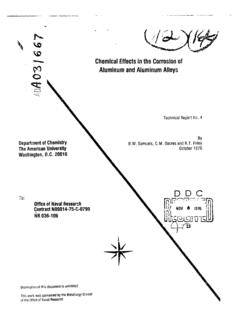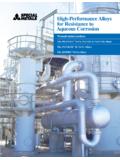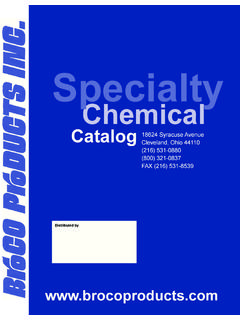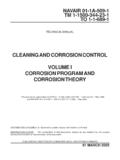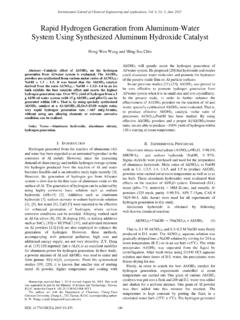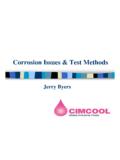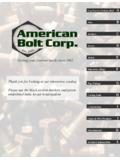Transcription of ORROIONOF N SUFAC SEAATEMTERALS
1 4'[. Technical Note N-1213S corrosion OF MATERIALS IN SURFACE SEAWATERAFTER 12 AND 18 MONTHS OF EXPOSUREByFred M. Reinhart and James F. JenkinsJanuary 1972 Approved for public release;distribution unlimitedNAVAL CIVIL ENGINEERING LABORATORYPort Hueneme, California byNATIONAL TECHNICALINFORMATION SERVICEC' CT--ei INS~nIedVA 22151TI; ORROIONOF MTERALS N SUFAC SEAATECORROSION OF MATERIALS IN SURFACE SEAWATER AFTER 12 AND 18 MONTHS OFEXPOSURET echnical Note N-1213YF M. Reinhart and James F. JenkinsABSTRACTA total of 1150 specimens of 189 different alloys were completelyimmersed in surface seawater for 12 and 18 months to obtain data forcomparison with deep ocean corrosion rates, types of corrosion and pit depths were highly alloyed nickel alloys , titanium alloys , silicon castirons, specialty stainless steels, columbium, tantalum and a tantalum-tungsten alloy were uncorroded in seawater both at the surface and corrosion rates of the copper base alloys , nickel base alloys ,steels, cast irons, lead, tin, lead-tin solder, molybdenum and tung-sten decreased with the concentration of oxygen in seawater, , thecorrosion rates were lower at depth than at the surface.]
2 The corrosionrates of Ni-200, Ni-Cu 402, 406, 410, K-500 and 45-55, Ni-Cr-Fe X750,Ni-Mo2, all steels, grey cast iron and alloy cast irons decreasedlinearly with the concentration of oxygen in copper base alloys , steels, cast irons, molybdenum, tungsten,lead and lead-tin solder corroded uniformly both at the surface and aluminum alloys were attacked by pitting and crevice corrosionand seawater was more aggressive at depth than at the surface for suchalloys. The effect of the concentration of oxygen in seawater on thecorrosion of aluminum alloys was stainless steels were attacked by pitting, tunneling and crev-ice corrosion , except 309, 316L, 317, 329, 633, 20Cb-3 and seawater was more aggressive than seawater at depth in promot-ing these types of corrosion on the stainless for public release; distribution unlimitedi' I i ido!
3 E Gi_!PREFACEThe Naval Civil Engineering Laboratory has been conducting aIresearch program to determine the effects of deep ocean environmentson materials. It is expected that this resaarch will establish thebest materials to be used in deep ocean Submersible Test Unit (STU) was designed, on which many testspecimens can be mounted. The STU can be lowered to the ocean floor Iand remain there for long periods of far, exposures have been made at two deep-ocean test sitesand at a surface seawater site in the Pacific Ocean. Seven STUs havebeen exposed and recovered. Test Site I (nominal depth of 6,000 feet)is approximately 81 nautical miles west-southwest of Port Hueneme,California, latitude 33*44'N and longitude 120*45'W. TesL Site II(nominal depth of 2,500 feet) is 75 nautical miles west of Port Hueneme,California, latitude 34*06'N and longitude 120*42'W.
4 A surface sea-water exposure site (V) was established at Point Mugu, California,(latitude 34*06'N and longitude 119*07'W) to obtain surface immersiondata for comparison report presents the results of the evaluation of the r allos exprosr ato det e surface immersion sitep ora penviodsrofm18 monthras. I sepce htti earhwl sals hUnclassifiedDOCUMENT CONTROL DATA. R & .IVV 1~. W4t,) .1 -0 hC n ?, -(C .SI1 _ tI P? I IIISc,.- ivta' ~,, of 1. d 10. *b',4C t,, *. 'T ahenKI Ife Ac*I Tp~ ., 04 Naval Civil Engineering Laboratory Unclass'.fiedPort Hiueneme, California 93043A MICRO? OF MATERIALS IN SURFACE SEAWATER AFTER 12 AND 18 MONTHSOF EXPOSUREa ,o ..etgs (Type. d doet)eFinal -June 1966-June 1971 Fred M. Reinhart and James F. Jenkinssi ) To-,L .0 O- 1. No OP 4rePJanuary 1972 103 10&a CONACA T VOR GRANT No Ae RJNVA *AA 11 ASG.
5 Ra*.% Technical Note N-1213a. I V.*IS. (Any attar .I,tob-y that may 0. for public release; distribution unlimitedNaval Facilities EnginettringCommandAtotal of 1150 specimens of 189 different alloys were completelyimmersed in surface seawater for 12 and 18 months to obtain data forcomparison with deep ocean corrosion rates, types of corrosion and pit depths were determinedSome highly alloyed nickel alloys , titanium alloys , silicon castirons, specialty stainless steels, columbium, tantalum and a tantalum-tungsten alloy were uncorroded in seawater both at the surface and corrosion rates of the copper base alloys , nickel base alloys ,steels, cast irons, lead, tin, lead-tin solder, molybdenum and tung-sten decreased with the concentration of oxygen in seawater, ,the corrosion rates were lower at depth than at the surface.)
6 Thecorrosion rates of Ni-200, Ni-Cu 402, 410, K-500 and 45-55, Ni-Cr-FeX750, Ni-Mo2, all steels, grey cast iron and alloy cast irons de-creased linearly with the concentration of oxygen in copper base alloys , steels, cast irons, inolybdenum, tungsten,lead and lead-tin solder corroded uniformly both at the surface and aidepth. ContinuedD N PG Unclassifieds/N Seutt L'". a LimaCorrosionMetalsAlloysSea waterShallow waterNickel AlloysTitanium AlloysSilicon cast ironsStainless steelsColumbiumTantalumTantalum-tungsten alloyCopper alloysLeadrinLead-tin solderMolybdenumTungstenSteelsCast ironiLIDD p"60" (BACK)/ Unclassified(PAGE s) ecurtty CatIOtlfCAU01,i 1 .. ; F' ' ' ..The aluminum alloys were attacked by pitting and crevice corrosionand seawater was more aggressive at depth than at the surface for suchalloys.
7 The effect of the concentration of oxygen in seawater on thecorrosion of aluminum alloys was stainless steels were attacked by pitting, tunneling and crevicecorrosion, except 309, 316L, 317, 329, 633, OCb-3 and seawater was more aggressive than seawater at depth in promot-ing thesc types of corrosion on the stainless development of deep diving vehicles which can stay submergedfor long periods of time has focused attention on the deep ocean as anoperating environment. This has created a need for information con-cerning the behavior of both common and potential materials of construc-tion at depths in the study the problems of construction in the deep ocean, project"Deep Ocean Studies" was established. Fundamental to the design, con-"struction and operation of structures, and their related facilities,is information with regard to the deterioration of materials in deepocean environments.
8 This portion of the project is concerned withdeterminirg the effects of these environments on the corrosion ofmetals ard order tr determine the differences between the corrosiveness ofseawater at depths and at the surface it is desirable to compare deepocean corrosion data with surface immersion data. Since surface datawas not available in the literature for many of the alloys exposed atdepths in the Pacific Ocean, it was decided to establish a surface ex-posure site to obtain this information. Therefore, a third site, des-ignated at Site V, was established at Point Mugu, California, latitude34*06'N and longitude 11907' locations of the thrce test sites, two deep ocean sites andthe surface site, are shown in Figure 1. The specific geographicallocations of the test sites and the average characteristics of the sea-water at these sites are given in Table pertaining to the performance of alloys in the deep oceanenvironments are given in References 1 through report presents a discussion of the results obtained of thecorrosion of various alloys exposed at the surface, Site V, for periodsof 12 and 18 AND DISCUSSIONSThe results presented and discussed herein also include the corro-sion data for the alloys exposed at the surface for the InternationalNickel Company, Inc.
9 Permission for their use has been granted byI. Dr. T. P. May, Reference The deep ocean data for de~ths of 2,500 and 6,000 feet after com-parable periods of exposure are included for comparison epoendt o etso 250ad600fe fe on(II4!/ aluminum ALLOYSThe chemical compositions of the aluminum alloys are given inTable 2 and their corrosion rates and types of corrosion in Table variations of the corrosion rates and maximum pit depths of thealloys with depth and with oxygen content of seawater are shown graphi-cally in Figures 2 through alloys corrode chiefly by the pitting and crevice typesin seawater, both of which are localized types, which means that thegreater portion of the surface area of a specimen is unattacked. There-fore, corrosion rates calculated from weight losses and expressed asmile per year, which indicates uniform thinning of the material, arevery misleading because they create an erroneous impression of the be-havior of the material.)
10 In order to present a more realistic pictureof the behavior of aluminum alloys , the maximum and average pit depthsand the maximum depth of crevice corrosion are also Figure 2 the corrosion rates of the aluminum alloys versusdepth are shown. The variation of the oxygen content of seawater withdepth is also shown in Figure 2. The corrosion rates of aluminum alloys1100-H14, 5083-H113 and 3003-H14 increase progressively with of the 6061-T6 and 2219-T81 alloys are greater at deptli than atthe surface but their increases are not progressive since their ratesat the 2,500-foot depth are greater than those at the 6,000-foot corrosion rate of 2024-0 at the 6,000-foot depth was greater thanat the surface, but at the 2,500-foot depth it was less than at thesurface. The corrosion rate of 5086-H34 decreased slightly with is shown in Figure 2 that based on corrosion rates the corrosion of5083-H113, 1100-H14 and 3003-H14 aluminum alloys are depth corrosion rates of aluminum alloys 2219-T81 and 6061-T6 in-creased with the decreasing concentration of oxygen in seawater whilethose of 5086-H34 decreased slightly as shown in Figure corrosion rates of aluminum alloys 1100-H14, 3003-H14, 2024-0and 5083-H113 are independent of the concentration of oxygen in sea-water as shown in Figure 4.










